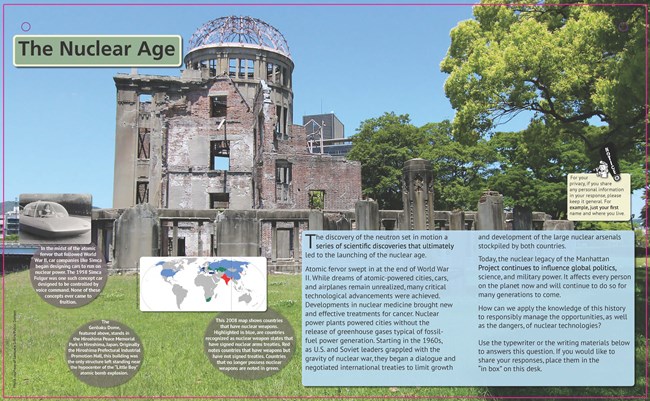Last updated: January 25, 2024
Article
B Reactor History Room: The Nuclear Age

See exhibit panel for specific image credits.
Main Text
Text at the bottom left reads: “The Genbaku Dome, featured above, stands in the Hiroshima Peace Memorial Park in Hiroshima, Japan. Originally the Hiroshima Prefectural Industrial Promotion Hall, this building was the only structure left standing near the hypocenter of the “Little Boy” atomic bomb explosion.”
At the middle left, a small, black-and-white inset photograph shows a woman sitting in row-boat like vehicle with a transparent bubble dome and V-shaped fins at the back. Text reads: “In the midst of the atomic fervor that followed World War II, car companies like Simca began designing cars to run on nuclear power. The 1958 Simca Fulgur was one such concept car designed to be controlled by voice command. None of these concepts ever came to fruition.”
In the center, a small, inset, rectangular world map shows countries highlighted in blue, red, and green. A caption reads: “This 2008 map shows countries that have nuclear weapons. Highlighted in blue, are countries recognized as nuclear weapon states that have signed nuclear arms treaties. Red notes countries that have weapons but have not signed treaties. Countries that no longer possess nuclear weapons are noted in green.”
At the bottom right, text continues: “The discovery of the neutron set in motion a series of scientific discoveries that ultimately led to the launching of the nuclear age.
“Atomic fervor swept in at the end of World War II. While dreams of atomic-powered cities, cars, and airplanes remain unrealized, many critical technological advancements were achieved. Developments in nuclear medicine brought new and effective treatments for cancer. Nuclear power plants powered cities without the release of greenhouse gases typical of fossil fuel power generation. Starting in the 1960s, as U.S. and Soviet leaders grappled with the gravity of nuclear war, they began a dialogue and negotiated international treaties to limit growth and development of the large nuclear arsenals stockpiled by both countries.
“Today, the nuclear legacy of the Manhattan Project continues to influence global politics, science, and military power. It affects every person on the planet now and will continue to do so for many generations to come.
“How can we apply the knowledge of this history to responsibly manage the opportunities, as well as the dangers, of nuclear technologies? Use the typewriter or the writing materials below to answers this question. If you would like to share your responses, place them in the “in box” on this desk. Notice: For your privacy, if you share any personal information in your response, please keep it general. For example, just your first name and where you live.”
Exhibit Panel Description
A color poster, entitled “The Nuclear Age,” features a severely damaged brick, domed building with burned and missing walls, and its dome but a metal skeleton.
Visit This Exhibit Panel
In-person visitation of the B Reactor is only authorized on guided tours offered by the Department of Energy.
